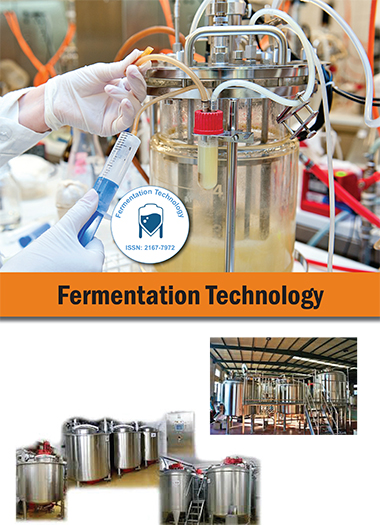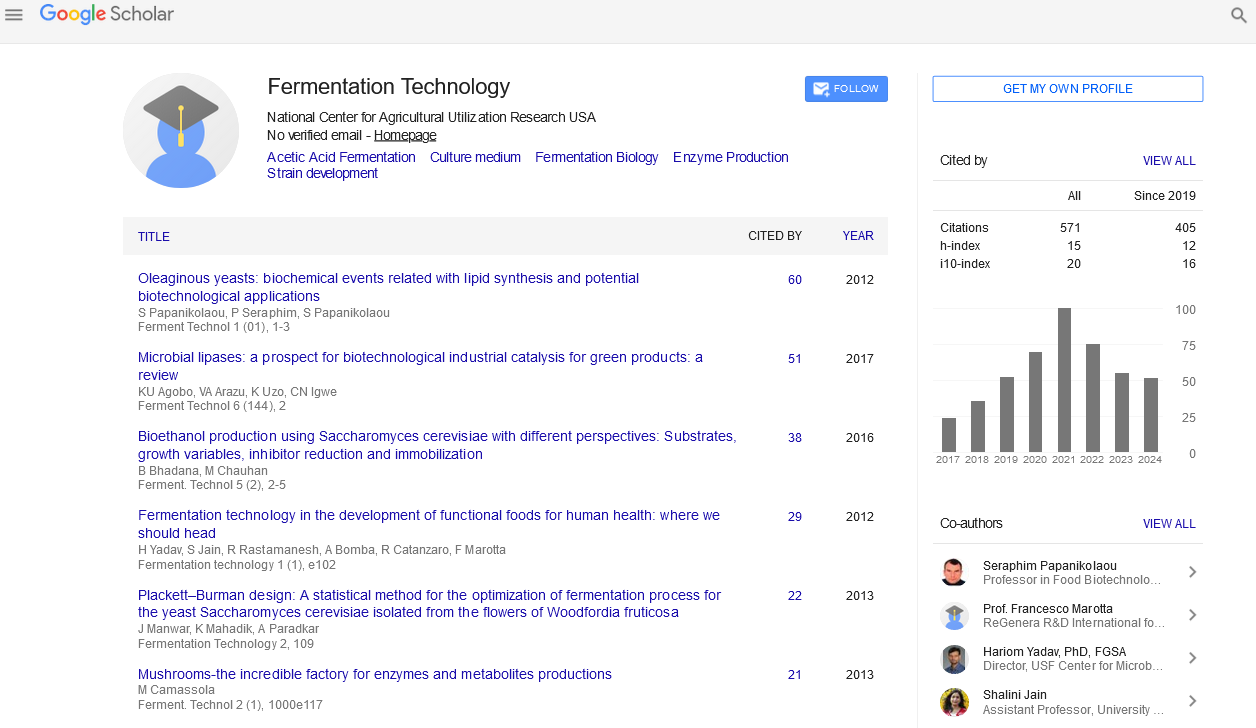Indexed In
- Open J Gate
- Genamics JournalSeek
- Access to Global Online Research in Agriculture (AGORA)
- RefSeek
- Hamdard University
- EBSCO A-Z
- OCLC- WorldCat
- Publons
Useful Links
Share This Page
Journal Flyer

Open Access Journals
- Agri and Aquaculture
- Biochemistry
- Bioinformatics & Systems Biology
- Business & Management
- Chemistry
- Clinical Sciences
- Engineering
- Food & Nutrition
- General Science
- Genetics & Molecular Biology
- Immunology & Microbiology
- Medical Sciences
- Neuroscience & Psychology
- Nursing & Health Care
- Pharmaceutical Sciences
Commentary - (2025) Volume 14, Issue 1
Advances in Microbial Fermentation for Sustainable Production of Bio-Based Chemicals
Russel Williams*Received: 26-Feb-2025, Manuscript No. FMT-25-29067; Editor assigned: 28-Feb-2025, Pre QC No. FMT-25-29067 (PQ); Reviewed: 13-Mar-2025, QC No. FMT-25-29067; Revised: 20-Mar-2025, Manuscript No. FMT-25-29067 (R); Published: 27-Mar-2025, DOI: 10.35248/2167-7972.25.14.177
Description
Microbial fermentation has emerged as an effective approach for producing a wide array of bio-based chemicals used across industries such as pharmaceuticals, agriculture, energy and food. Traditionally employed for producing alcohol and organic acids, fermentation is now a key tool in modern biotechnology, offering environmentally compatible alternatives to petrochemical processes. Recent innovations have focused on metabolic engineering, novel microbial strains and improved process control to enhance yield and productivity.
Microbial strain development
The choice and improvement of microbial strains are central to fermentation success. Naturally occurring strains like Escherichia coli, Saccharomyces cerevisiae and Corynebacterium glutamicum have been widely utilized for the synthesis of ethanol, lactic acid and amino acids, respectively. With advances in genome editing tools such as CRISPR-Cas systems, researchers have been able to fine-tune metabolic pathways to increase flux toward target compounds.
Additionally, extremophilic microbes have gained attention for their ability to thrive in unconventional fermentation conditions such as high temperatures or acidic environments, thus minimizing contamination and improving downstream processing efficiency.
Feedstock diversification
Feedstock availability and cost significantly influence the economics of fermentation. The reliance on food-based substrates such as glucose and corn syrup has been a point of contention, leading to extensive exploration of alternative carbon sources. Lignocellulosic biomass, agricultural residues and even industrial by-products like glycerol are now being studied as sustainable inputs. Pre-treatment and hydrolysis technologies have improved, enabling better conversion of complex materials into fermentable sugars.
These developments not only reduce production costs but also support waste minimization and resource recovery goals.
Bioprocess optimization
Modern fermentation systems are moving toward continuous and semi-continuous operations with real-time monitoring. Process Analytical Technologies (PAT) allow close monitoring of fermentation variables such as pH, oxygen levels and substrate concentration, enabling more consistent yields.
Bioreactor design has also evolved, with improvements in aeration, agitation and temperature control to support high-cell-density cultures. The use of immobilized cells and biofilm reactors has opened new avenues for improving productivity and reusability of microbial systems.
Product spectrum and applications
The range of chemicals produced through microbial fermentation is continuously expanding. Short-chain alcohols (e.g., ethanol, butanol), organic acids (e.g., succinic, citric and itaconic acids) and amino acids (e.g., lysine, glutamate) are being produced on an industrial scale.
Additionally, microbial fermentation is now being employed for the biosynthesis of biopolymers like Polyhydroxyalkanoates (PHAs) and Polylactic Acid (PLA), which are finding increasing applications in biodegradable plastics. Other areas seeing progress include the microbial production of vitamins, pigments and pharmaceutical precursors.
Environmental and economic considerations
The environmental footprint of microbial fermentation is significantly lower than that of conventional chemical synthesis. Greenhouse gas emissions, water usage and energy consumption are comparatively reduced, particularly when renewable feedstock’s are used.
Economically, the sector is benefiting from integration with circular economy principles. For instance, using food processing waste and dairy effluents as fermentation substrates offers dual benefits of waste treatment and resource recovery. Public-private partnerships and government incentives in the bio-economy space are also facilitating commercialization and technology transfer.
Challenges and future directions
Despite its progress, microbial fermentation faces several challenges. These include the need for efficient downstream processing, tolerance of microbes to high product concentrations and competition with fossil-derived alternatives.
Future research is focusing on synthetic biology to design novel biosynthetic routes, adaptive laboratory evolution for strain robustness and hybrid processes combining chemical catalysis with fermentation. Artificial intelligence and machine learning are being explored to predict optimal fermentation conditions and accelerate strain screening.
Conclusion
Microbial fermentation is undergoing a transformation driven by innovations in strain development, feedstock utilization and bioprocess engineering. It plays an important in advancing sustainable production systems and reducing reliance on nonrenewable resources. Continued investment in research, infrastructure and policy frameworks will be essential to scale up these technologies for widespread industrial adoption.
Citation: Williams R (2025). Advances in Microbial Fermentation for Sustainable Production of Bio-Based Chemicals. Ferment Technol. 14:177.
Copyright: © 2025 Williams R. This is an open-access article distributed under the terms of the Creative Commons Attribution License, which permits unrestricted use, distribution and reproduction in any medium, provided the original author and source are credited.

